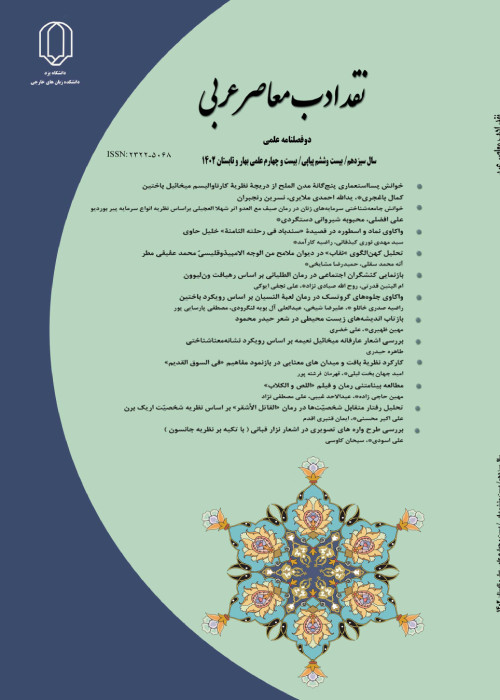Semantic Deviation of the Quran in Salah Abd Al-Sabur's Poetry
Author(s):
Abstract:
Due to the uniqueness of its structure and characteristics، the Noble Quran has always had a significant and influential presence in the writings of poets and literary scholars in different ages. Moreover، the Quranic verses and concepts have always been used in literary works. As the Holey Quran has always been a source of inspiration for literary writers، there are frequent examples of divine verses، rhetorical patterns، and concepts taken from this holy book in their works. Salah Abd Al-Sabur is among the contemporary Arab poets who are inspired by the Noble Quran by including the lexical as well as syntactic features of the divine verses in their works. This poet is also frequently influenced by the Quranic themes and contents. The choice of form، lexis، and structure in his poetry reflects the poet''s strong influence by the holy book. Actually، his poetry reminds the reader of the special form and content of the Noble Quran. Inspired by the divine verses، Abd Al-Sabur speaks about the transitory nature of the world، man’s mortality، and death. The poet tries to depict the implied facts of the Quranic verses in his works. In addition، he attempts to combine divine concepts with his words to compose his verse. In some poems، with a delicate change in the structure of the Quranic verses، the poet tries to recreate the same simile or metaphor. In such cases، the elements which are employed to make the comparison in both of these two literary techniques are actually taken from the divine verses. In some other poems، however، the poet borrows Quranic words to create new similes and metaphors. The present study is an attempt to investigate semantic deviations in the Quranic rhetorical samples of Abd-Al-Sabur''s poetry along with both the syntagmatic and paradigmatic dimensions. The results of the study of paradigmatic relations in the samples revealed that metaphor is more frequent than irony. Concerning the syntagmatic relations، on the other hand، it was found that simile is more frequent than figure and figurative language. Finally، based on the results of the study of the paradigmatic and syntagmatic dimensions of Quranic rhetorical samples، attempt was made to evaluate the way the poet reflects the aesthetic aspects of the Holy Quran in his poetry.
Keywords:
Quran , Salah Abd , Al , Sabur , semantic deviation , syntagmatic , paradigmatic
Language:
Persian
Published:
نشریه نقد ادب معاصر عربی, Volume:5 Issue: 8, 2015
Page:
1
https://magiran.com/p1418277
دانلود و مطالعه متن این مقاله با یکی از روشهای زیر امکان پذیر است:
اشتراک شخصی
با عضویت و پرداخت آنلاین حق اشتراک یکساله به مبلغ 1,390,000ريال میتوانید 70 عنوان مطلب دانلود کنید!
اشتراک سازمانی
به کتابخانه دانشگاه یا محل کار خود پیشنهاد کنید تا اشتراک سازمانی این پایگاه را برای دسترسی نامحدود همه کاربران به متن مطالب تهیه نمایند!
توجه!
- حق عضویت دریافتی صرف حمایت از نشریات عضو و نگهداری، تکمیل و توسعه مگیران میشود.
- پرداخت حق اشتراک و دانلود مقالات اجازه بازنشر آن در سایر رسانههای چاپی و دیجیتال را به کاربر نمیدهد.
In order to view content subscription is required
Personal subscription
Subscribe magiran.com for 70 € euros via PayPal and download 70 articles during a year.
Organization subscription
Please contact us to subscribe your university or library for unlimited access!




